
The 40.6 cm SK C/34, sometimes known as the Adolfkanone, was a German naval gun, designed in 1934 by Krupp and originally intended for the early H-class battleships.

A railway gun, also called a railroad gun, is a large artillery piece, often surplus naval artillery, mounted on, transported by, and fired from a specially designed railway wagon. Many countries have built railway guns, but the best-known are the large Krupp-built pieces used by Germany in World War I and World War II. Smaller guns were often part of an armoured train. Only able to be moved where there were good tracks, which could be destroyed by artillery bombardment or airstrike, railway guns were phased out after World War II.

Coastal artillery is the branch of the armed forces concerned with operating anti-ship artillery or fixed gun batteries in coastal fortifications.
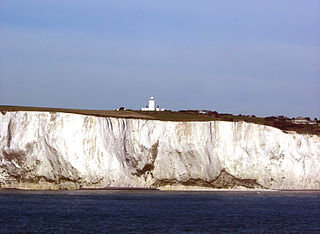
South Foreland is a chalk headland on the Kent coast of southeast England. It presents a bold cliff to the sea, and commands views over the Strait of Dover. It is centred 3 miles (4.8 km) northeast of Dover and 15 miles south of North Foreland. It includes the closest point on the Island of Britain to the European mainland at a distance of 20.6 miles (33.2 km).
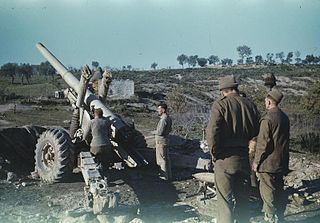
The BL 5.5-inch gun was a British artillery gun introduced during the middle of the Second World War to equip medium batteries.

The BL 4.5 inch medium gun was a British gun used by field artillery in the Second World War for counter-battery fire. Developed as a replacement for the BL 60-pounder gun it used the same carriage as the BL 5.5-inch medium gun but fired a lighter round further.

Cap Gris-Nez is a cape located in Audinghen, a commune of the Pas-de-Calais département in northern France.

The Ordnance BL 6 inch 26cwt howitzer was a British howitzer used during World War I and World War II. The qualifier "26cwt" refers to the weight of the barrel and breech together which weighed 26 long hundredweight (1.3 t).

The BL 13.5 inch Mk V gun was a British heavy naval gun, introduced in 1912 as the main armament for the new super-dreadnought battleships of the Orion class. The calibre was 13.5 inches (343 mm) and the barrels were 45 calibres long i.e. 607.5 inches. The guns were greatly superior to the unrelated earlier 13.5-inch (30-calibre) Mk I to Mk IV guns used on the Admiral, Trafalgar and Royal Sovereign classes completed between 1888 and 1896.
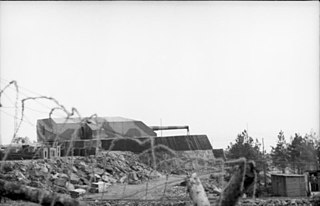
The 38 cm SK C/34 naval gun was developed by Germany mid to late 1930s. It armed the Bismarck-class battleships and was planned as the armament of the O-class battlecruisers and the re-armed Scharnhorst-class battleships. Six twin-gun mountings were also sold to the Soviet Union and it was planned to use them on the Kronshtadt-class battlecruisers, however, they were never delivered. Spare guns were used as coastal artillery in Denmark, Norway and France. One gun and one barrel is currently on display at respectively Møvig Fortress outside Kristiansand and Bunkermuseum Hanstholm, Denmark.

The Ordnance BL 6 inch 30cwt howitzer was a British medium howitzer used in the Second Boer War and early in World War I. The qualifier "30cwt" refers to the weight of the barrel and breech together which weighed 30 hundredweight (cwt) : 30 × 112 lb = 3,360 lb. It can be identified by the slightly flared shape of the muzzle and large recuperator springs below the barrel.

The BL 6-inch gun Mark VII was a British naval gun dating from 1899, which was mounted on a heavy travelling carriage in 1915 for British Army service to become one of the main heavy field guns in the First World War, and also served as one of the main coast defence guns throughout the British Empire until the 1950s.

HMS General Craufurd was the one of eight Lord Clive-class monitors built for the Royal Navy during World War I. Their primary armament was taken from obsolete pre-dreadnought battleships. The ship spent the war in the English Channel bombarding German positions along the Belgian coast as part of the Dover Patrol. She participated in the failed First and Second Ostend Raids in 1918, bombarding the defending coastal artillery as the British attempted to block the Bruges–Ostend Canal. Later that year General Craufurd supported the coastal battles during the Hundred Days Offensive until the Germans evacuated coastal Belgium in mid-October. The ship was decommissioned almost immediately after the war ended the following month, but she was reactivated in 1920 to serve as a gunnery training ship for a year. General Craufurd was sold for scrap in 1921.
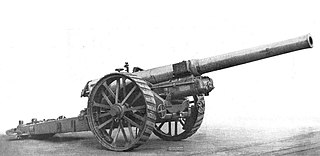
The British BL 6-inch gun Mk XIX was introduced in 1916 as a lighter and longer-range field gun replacement for the obsolescent BL 6-inch gun Mk VII.
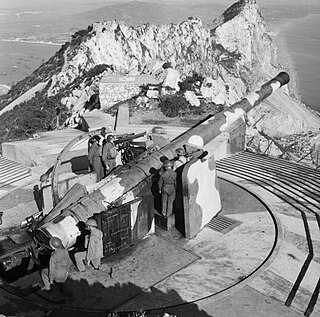
The BL 9.2-inch Mk IX and Mk X guns were British breech loading 9.2-inch (234 mm) guns of 46.7 calibre, in service from 1899 to the 1950s as naval and coast defence guns. They had possibly the longest, most varied and successful service history of any British heavy ordnance.

The BL 18-inch railway howitzer was a British railway gun developed during World War I. Part of the progression of ever-larger howitzers on the Western Front, it did not enter service until 1920.

Operation Undergo was an attack by the 3rd Canadian Infantry Division on the German garrison and fortifications of the French port of Calais, during September 1944. A subsidiary operation was executed to capture German long-range, heavy artillery at Cap Gris Nez, which threatened the sea approaches to Boulogne. The operation was part of the Clearing the Channel Coast undertaken by the First Canadian Army, following the success of Operation Overlord and the break-out from Normandy. The assault on Calais used the tactics of Operation Wellhit at Boulogne, sealing the town, bombardments from land, sea and air, followed by infantry assaults supported by armour, including flame-throwing tanks and creeping barrages.

The BL 8 inch gun Mark VIII was the main battery gun used on the Royal Navy's County-class cruisers, in compliance with the Washington Naval Treaty of 1922. This treaty allowed ships of not more than 10,000 tons standard displacement and with guns no larger than 8 inches (203 mm) to be excluded from total tonnage limitations on a nation's capital ships. The 10,000 ton limit was a major factor in design decisions such as turrets and gun mountings. A similar gun formed the main battery of Spanish Canarias-class cruisers. In 1930, the Royal Navy adopted the BL 6 inch Mk XXIII naval gun as the standard cruiser main battery in preference to this 8-inch gun.

The Todt Battery, also known as Batterie Todt, was a battery of coastal artillery built by Nazi Germany during World War II, located in the hamlet of Haringzelles, Audinghen, near Cape Gris-Nez, Pas de Calais, France.

Battery Oldenburg is a German artillery battery, built during World War II as part of the Atlantic Wall, and situated east of Calais. The battery began in 1940 with artillery guns in an open emplacement. The Organisation Todt built casemates around two 240mm guns during the war.


























